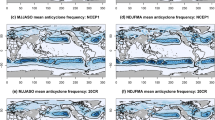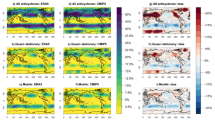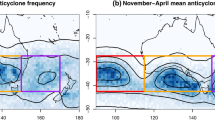Abstract
A climatology of anticyclones generated by an objective automatic scheme applied to 15 years of once-daily Australian Bureau of Meteorology hemispheric analyses is presented. Contour maps of the anticyclone system density, positions of formation and dissipation together with other statistics are shown. The distribution of anticyclones through the hemisphere was found to be dominated by a mid latitude belt of high density, located in the band 25–42°S, typically 24° south of the time-mean subtropical ridge. Within this band the anticyclone density displays considerable structure with greater system numbers over the eastern parts of the three subtropical ocean basins in the vicinity of the three subtropical ocean time-mean anticyclones. During winter the system density displays a bifurcation in the New Zealand sector, with the highest density along the 30 and 45°S latitude bands. The movement of systems in the subtropical ocean basins was found to be in a general easterly direction with a weak equatorwards component, the transport of systems closely following the orientation of the belt of highest system density. In the vicinity of the African and South American continents, movement was more complex with east-south-east motion upstream, and east-north-east movement downstream, the net transport being such as to encourage a general steering of systems around the continental land masses more particularly during the warmer seasons. To highlight the dynamic role played by these systems and their cyclonic counterparts, we present a limited investigation of the response of Southern Hemisphere synoptic systems to variations of the broader atmospheric system and compare these findings to those obtained by more traditional analysis techniques.
Similar content being viewed by others
References
Browne ML (1975) Anticyclones in the Australia-New Zealand region. N Z Meteorol Service Tech No 228
Chen WY (1982) Assessment of Southern Oscillation sea level pressure indices. Mon Weather Rev 110:800–807
Climate Analysis Center (1986) Climate diagnostic bulletin. NMC National Weather Service, Washington, DC vol 86(4)
Gibbs WJ (1953) A comparison of hemispheric circulations with particular reference to the western Pacific. Q J R Meteorol Soc 79:121–136
Guymer LB (1986) Procedures and concepts used in Southern Hemisphere analyses at WMC Melbourne. Proc Second Int Conf Southern Hemisphere Meteorol, Wellington, New Zealand, December 1986. Am Meteorol Soc, pp 10-16
Hepworth MWC (1893) The tracks of ocean wind systems in transit across Australiasia. Q J R Meteorol Soc 19:34–38
Hepworth MWC (1913) National Antarctic Expedition, 1901–1904, Part II, Meteorology, R Soc, London
Höflich O (1984) Climate of the South Atlantic Ocean. In: World survey of climatology, vol 15. Elsevier, Amsterdam, pp 1–191
Jones DA, Simmonds I (1993a) Time and space spectral analyses of Southern Hemisphere sea level pressure variability. Mon Weather Rev 121:661–672
Jones DA, Simmonds I (1993b) A climatology of Southern Hemisphere extratropical cyclones. Clim Dyn 9:131–145
Karelsky S (1961) Monthly and seasonal anticyclonicity and cyclonicity in the Australian Region - 15 years (1946–1960) averages. Meteorol Study no 13. Bureau of Meteorology, Australia
Karelsky S (1963) Geographical distribution of pressure in the centres of surface lows and highs in the Australian region in January and July, 1952–1963. Austral Meteorol Mag 43:15–23
Kep SL (1984) Some patterns of Southern Hemisphere cyclogenesis, cyclone tracks and their relations to climatic variables and victoria rainfall. MSc Report (unpublished), Department of Meteorology, University of Melbourne, Parkville, Australia
Kidson JW (1925) Some periods in Australian weather. Bull no 17. Bureau of Meteorology, Australia
Kiladis GN, Diaz HF (1986) An Analysis of the 1877–78 ENSO episode and comparison with 1982–83. Mon Weather Rev 114:1035–1047
Kiladis GN, Diaz HF (1989) Global climatic anomalies associated with extremes in the Southern Oscillation. J Clim 2:1069–1090
Kiladis GN, van Loon H (1988) The Southern Oscillation. Part VII: meteorological anomalies over the Indian and Pacific sectors associated with the extremes of the oscillation. Mon Weather Rev 116:120–136
Le Marshall JF, Kelly GAM (1981) A January and July climatology of the Southern Hemisphere based on daily numerical analyses 1973–77. Austral Meteorol Mag 29:115–123
Le Marshall JF, Kelly GAM, Karoly DJ (1985) An atmospheric climatology of the Southern Hemisphere based on ten years of daily numerical analyses (1972–82): I overview. Austral Meteorol Mag 33:65–85
LeTreut H, Kalnay E (1990) Comparison of observed and simulated cyclone frequency distribution as determined by an objective method. Atmosfera 3:57–71
Leighton RM (1992) Monthly anticyclonicity and cyclonicity in the Southern Hemisphere: averages for March and September. Weather Clim 12:76–82
Leighton RM (1994) Monthly anticyclonicity and cyclonicity in the Southern Hemisphere: averages for January, April, July and October. J Clim 14:33–46
Leighton RM, Deslandes R (1991) Monthly anticyclonicity and cyclonicity in the Australian region: averages for January, April. July and October. Austral Meteorol Mag 39:149–154
Lejenäs H (1984) Characteristics of Southern Hemisphere blocking as determined from a time series of observational data. Q J R Meteorol Soc 110:967–979
Lockyer WJS (1910) Southern Hemisphere surface-air circulation. Solar Physics Committee. London HM Stationary Office
van Loon H (1956) Blocking action in the Southern Hemisphere, part 1. Notos 5:171–177
van Loon H, Madden RA (1981) The Southern Oscillation. Part I: global associations with pressure and temperature in the northern winter. Mon Weather Rev 109:1150–1162
McBride JL, Nicholls N (1983) Seasonal relationship between Australian rainfall and the Southern Oscillation. Mon Weather Rev 111:1998–2004
Meldrum C (1861) Synoptic weather charts for the Indian Ocean for the month of January, February; March. Edinburgh
Murray RJ (1988) The Development of a computer-based scheme for the automatic location and tracking of cyclone centres. CE'Report (unpublished), Dept of Meteorology, University of Melbourne, Parkville Australia
Murray RJ, Simmonds I (1991a) A numerical scheme for tracking cyclone centres from digital data. Part I: development and operation of the scheme. Austral Meteorol Mag 39:155–166
Murray RJ, Simmonds I (1991b) A numerical scheme for tracking cyclone centres from digital data. Part II: application to January and July GCM simulations. Austral Meteorol Mag 39:167–180
Neal AB (1972) MSL Cyclones and Anticyclones in November 1969 and June 1970. Austral Meteorol Mag 20:217–230
Nicholls N (1989) Sea surface temperatures and Australian winter rainfall. J Clim 2:965–973
Noar PF (1983) Numerical modelling of blocking with reference to June 1982. Austral Meteorol Mag 31:37–49
Nydam PG (1989) Aspects of the Southern Hemisphere circulation during the 1982/83 ENSO Episode. MSc Report (unpublished), Department of Mathematics, Monash University, Clayton, Australia
Oort AH, Peixóto JP (1983) Global angular momentum and energy balance requirements from observations. Adv Geophys 25:355–490
Palmer CW (1942) Synoptic analysis over the Southern Hemisphere. Prof Note, New Zealand, Meteorological Office, Wellington. No 1
Rocha A (1992) The influence of global sea surface temperatues on southern African summer climate. PhD Thesis (unpublished), Department of Meteorology, University of Melbourne, Parkville, Australia
Russell HC (1893) Moving Anticylones in the Southern Hemisphere. Q J R Meteorol Soc 19:23–34
Simmonds I, Wu X (1993) Cyclone behavior response to changes in Winter Southern Hemisphere sea ice concentration. Q J R Meteorol Soc 119:1121–1148
Streten NA (1983) Circulation contrasts in the Southern Hemisphere winters of 1972 and 1973. Austral Meteorol Mag 31:161–170
Swanson GS, Trenberth KE (1981) Interannual variability in the Southern Hemisphere troposphere. Mon Weather Rev 109:1890–1897
Taljaard JJ (1967) Development, distribution, and movement of cyclones and anticyclones in the Southern Hemisphere during the IGY. J Appl Meteorol 6:973–987
Taljaard JJ (1972) Synoptic meteorology of the Southern Hemisphere. Meteorol Monogr 13:139–213
Taljaard JJ, van Loon H (1984) Climate of the Indian Ocean south of 35 S. In: World survey of climatology, vol 15. Elsevier, Amsterdam, pp 505–601
Trenberth KE (1976) Spatial and temporal variations of the Southern Oscillation. Q J R Meteorol Soc 102:639–653
Trenberth KE (1979) Interannual variability of the 500 mb zonal mean flow in the Southern Hemisphere. Mon Weather Rev 107:1515–1524
Trenberth KE (1981) Observed Southern Hemisphere eddy statistics at 500 mb: frequency and spatial dependence. J Atmos Sci 38:2585–2605
Trenberth KE (1991) Storm tracks in the Southern Hemisphere. J Atmos Sci 48:2159–2178
Trenberth KE, Mo KC (1985) Blocking in the Southern Hemisphere. Mon Weather Rev 113:3–21
Trenberth KE, Shea DJ (1987) On the evolution of the Southern Oscillation. Mon Weather Rev 115:3078–3096
Walker GT (1923) Correlation in seasonal variations of whether, VIII. A preliminary study of world weather (World weather 1). Mem Indian Meteorol Dept vol 23(4), pp 75–131
Walker GT, Bliss EW (1932) World weather V. Mem R Meteorol Soc vol 4(36), pp 53–84
Zhang XG, Casey TM (1992) Long-term variations in the Southern Oscillation and relationships with Australian rainfall. Austral Meteorol Mag 40:211–225
Author information
Authors and Affiliations
Rights and permissions
About this article
Cite this article
Jones, D.A., Simmonds, I. A climatology of Southern Hemisphere anticyclones. Climate Dynamics 10, 333–348 (1994). https://doi.org/10.1007/BF00228031
Received:
Accepted:
Issue Date:
DOI: https://doi.org/10.1007/BF00228031




